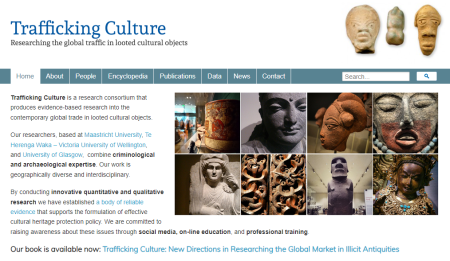Trafficking Culture: researching the global traffic in looted cultural objects

“Trafficking Culture is an interdisciplinary research consortium with an overall interest in understanding the illicit trade in cultural objects, developing and refining an evidence base for promoting effective policy interventions to reduce this global form of trafficking.
Our researchers, based at Maastricht University, Oxford University, University of Victoria at Wellington, and University of Glasgow combine criminological and archaeological expertise and participate in a number of independent, but thematically-overlapping research projects, supported by the rest of the Trafficking Culture consortium and by other colleagues. Our work is geographically diverse and inherently interdisciplinary.
From 2012 until 2016 this research programme was housed at the University of Glasgow’s Scottish Centre for Crime and Justice Research and was funded by the European Research Council.
General Interests:
Analysis of antiquities sales and acquisitions data in order to provide size and shape estimates for the international illicit market
Development and evaluation of cultural heritage policy
Ethnographic research and fieldwork into antiquities looting and trafficking routes, as well as heritage security
Comparative analysis of parallel and related illicit commodities smuggling, including wildlife, fine art, fossils, and drugs
Qualitative interview of trade participants, regulators, and stakeholders
Our guiding principle is that the trade is demand-led and that effective countermeasures need to be focused on shrinking the destination market by reducing demand. By conducting innovative quantitative and qualitative research we have established and are growing a body of reliable, empirical evidence that can support the formulation of more effective cultural heritage protection policy. We are also committed to raising public and political awareness of the trade and of possible solutions to these problems by means of social media and other means of on-line education, as well as by targeted professional training.”
